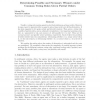Free Online Productivity Tools
i2Speak
i2Symbol
i2OCR
iTex2Img
iWeb2Print
iWeb2Shot
i2Type
iPdf2Split
iPdf2Merge
i2Bopomofo
i2Arabic
i2Style
i2Image
i2PDF
iLatex2Rtf
Sci2ools
AAAI
2008
2008
Determining Possible and Necessary Winners under Common Voting Rules Given Partial Orders
Usually a voting rule requires agents to give their preferences as linear orders. However, in some cases it is impractical for an agent to give a linear order over all the alternatives. It has been suggested to let agents submit partial orders instead. Then, given a voting rule, a profile of partial orders, and an alternative (candidate) c, two important questions arise: first, is c guaranteed to win, and second, is it still possible for c to win? These are the necessary winner and possible winner problems, respectively. Each of these two problems is further divided into two sub-problems: determining whether c is a unique winner (that is, c is the only winner), or determining whether c is a co-winner (that is, c is in the set of winners). We consider the setting where the number of alternatives is unbounded and the votes are unweighted. We completely characterize the complexity of possible/necessary winner problems for the following common voting rules: positional scoring rules, Copel...
| Added | 02 Oct 2010 |
| Updated | 02 Oct 2010 |
| Type | Conference |
| Year | 2008 |
| Where | AAAI |
| Authors | Lirong Xia, Vincent Conitzer |
Comments (0)

